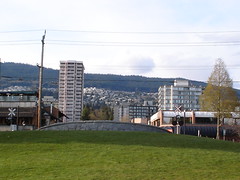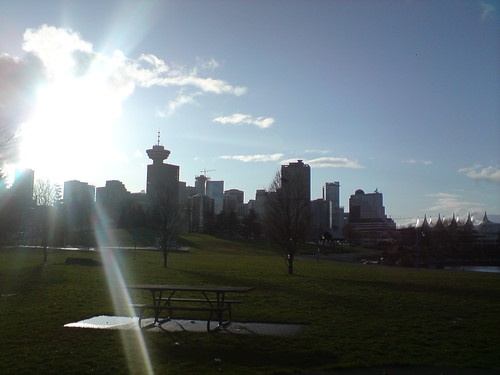 Vancouver’s evolutionary urban and industrial development trajectories have been documented by several scholars (Barnes et al, 1992, Hutton 1997, 2004, Barnes and Hutton 2009) in the past couple of decades. The city of Vancouver’s planning processes and departments have also been lauded in the popular press as well as in the academic literature as being ‘cutting-edge’ and innovative.
Vancouver’s evolutionary urban and industrial development trajectories have been documented by several scholars (Barnes et al, 1992, Hutton 1997, 2004, Barnes and Hutton 2009) in the past couple of decades. The city of Vancouver’s planning processes and departments have also been lauded in the popular press as well as in the academic literature as being ‘cutting-edge’ and innovative.
With burgeoning electronic arts, gaming and information technology industries, Vancouver industrial base appears to be poised to become fundamentally a creative/information society. Clusters of Information Technology (IT) firms have emerged in Gastown and Yaletown (an area that used to be primarily derelict industrial) and this area continues to flourish with new tech-based startups (Hutton 2008). Vancouver isn’t the first city where this has occurred. Several European (including Barcelona and Milan) and Latin American cities have experienced the growth of information-based industries (a process that I have called tertiarization – Pacheco-Vega 2008, Evans 2009).
When I conducted my doctoral dissertation research, I focused on the evolutionary transformation of two cities and the industrial clusters that were embedded in them. I have been puzzled by the re-emergence of a trend to change land use from industrial to residential, sparked in part by the decline of industrial activity in certain urban centres. This coupled industrial/urban restructuring presents a number interesting challenges: how can we provide enough land for residential purposes and what to do about the shifting industrial base in the city.
In a city that is contained and encased (surrounded by oceans on one side and by other municipalities at the south and east), Vancouver has no additional land base to grow horizontally and therefore, planners in this city have needed to consider vertical growth and increased urban density. At the same time, an increasing amount of industrial land has been shifted to residential use (for example, the case of the South East False Creek area).
Both themes (the evolutionary dynamics of urban/industrial land use and the need for increased density) are worthy of examination, and I plan to write about them on this blog in the near future, but for now, I want to just focus on the second one (increased density), since it’s the topic of the recently approved laneway housing proposal that is embedded within the EcoDensity initiative. For those not familiar with EcoDensity, you can read the full Executive Summary of the initiative.
 A cursory and preliminary literature review (using Google Scholar and library databases) yielded very little to no academic analysis of the initiative itself (a surprising finding, I might add). I did find some articles and a Masters thesis that dealt in some tangential way with the initiative, but nothing really in-depth on the initiative itself (which gives me great hope for this being a good research project). I am puzzled about EcoDensity (and frankly, skeptical) for several reasons:
A cursory and preliminary literature review (using Google Scholar and library databases) yielded very little to no academic analysis of the initiative itself (a surprising finding, I might add). I did find some articles and a Masters thesis that dealt in some tangential way with the initiative, but nothing really in-depth on the initiative itself (which gives me great hope for this being a good research project). I am puzzled about EcoDensity (and frankly, skeptical) for several reasons:
First, affordability is dependent not on the capacity of home buyers or renters to purchase or rent, but on the price that developers and renters charge. This price is not controlled by the government and therefore one of the two “auxiliary” wheels in the EcoDensity charter ends being a moot point. Last year you could easily read the advertisements for “spacious 480 sq ft” apartments priced in the $ 300,000 mark (in Vancouver).
Second, livability has embedded substantial psychological considerations. The psychology of buyers and/or renters can’t be influenced by policy decisions. I currently live in a small apartment that is near 500 sq ft. For me, compared to my parents’ house, this apartment is ridiculously small. For me, it’s livable. I don’t know if my parents would have chosen to live in such a small space. For many of my friends, the idea of a house (single family dwelling) with a backyard is what they would call a livable home.
Third, increased density doesn’t guarantee increased sustainability. There are strong arguments in favor of the idea that increased density leads to a lower ecological footprint, including the fact that having more dense regions would mean that residents would have access to more services (and they would be able to reach there by more sustainable, less-impacting means – including walking and/or cycling). But there is no guarantee that this will be the case. The element that policy makers seem to forget here is that behavioral change is not easy. I can assure you that there are people who live in really dense areas who still drive just a few blocks (I’ve witnessed this myself).
I am really curious to see the actual effect of laneway housing and secondary suites on housing affordability. While I am glad that the city recognizes that affordability is a complex issue, I would like to see a more fleshed-out scheme within the EcoDensity charter to influence affordability.
As I mentioned at the beginning of this post, these are just preliminary thoughts. I’ve always been intrigued by the urban planning processes of the city that I’ve called home for almost a decade, and the EcoDensity initiative (and the collateral discussions) could be a good case study. Now, if I only had a research grant to undertake such analysis!
I am, as always, interested in your thoughts on EcoDensity, the laneway housing proposal, the secondary suites proposal.


I think your second point — about the psychology — is the most intriguing.
Since I first heard about laneway housing, I’ve wondered whether it would make a second tier of homeowner in our neighbourhoods…a necessary evil for the first tier of homeowner (those with the big houses who had to sell their coach house to pay their mortgage).
This feeling comes from what I’ve experienced as a renter in several locations in the city. The homeowner living on the other side of the house, who needs your rent to pay her mortgage, but wishes you weren’t there and demonstrates that. The other homeOWNers on the block, who can’t wait for the student rental house in Kits to get condemned so they won’t have to deal with rowdy renters anymore.
Now, as I understand it, the idea behind laneway housing is to subdivide the property — so the coach house occupants would own their land. But I would still anticipate high prices, little space, and possible disdain. A serf in the land lord’s backyard.
So, I share your concern that this might not be as liveable as advertised.
I’m surprised you didn’t find any research. DId you only search for papers specifically on Vancouver? because these principles don’t sound new. I suspect there is research on similar issues in other cities. Certainly the density/sustainability thing.
@ JoVE – I only searched for “EcoDensity”. I’ve looked at the literature on urban density and sustainability, for sure, but I wanted to see if EcoDensity itself had been studied. It has been mentioned only very marginally.
@ Lisa – I think the psychology of livelihood is very under-studied (I have a very good Mexican friend who is a researcher in environmental psychology and does study this kind of thing)
Sorry Lisa but Laneway Housing will be NON STRATA which means rental property only BUT, as shown, The City can always change its mind and change zoning nearly overnight. So if you do manage to buy a house, don’t ever think you’ll have “owner rights”.
So Laneway Housing may slightly increase the number of rental properties around Vancouver but it will not buying a house more affordable. For the past 10 and more years developers have constantly outbid ordinary people for “affordable” properties. The house gets bulldozed and the new house sells for two or three times the price of the old house. Can’t really see anyone buying one of those houses for $2-3M and then needing a “mortgage helper”? Can you?
Where I live, of the 8 houses that are around our little house, there are 5 basement suites but just one of them is occupied. It is cheaper to build a basement suite than build a laneway house so why are they empty? Just too much hassle for a homeowner to take care of.
So Laneway Housing is just another bit of the sloganeering pioneered by Sam Sullivan with his EcoDensity. The only people who benefit are developers and builders as they can build with fewer and fewer restrictions which means more money in the developer’s pockets.
Purchasing a house is still possible but people have to be willing to reduce their lifestyles and put all their cash onto the mortgage. That’s how we managed to pay off our house.
Laneway housing WILL provide a certain amount of relief, but ultimately all the infill opportunities get used up, and you get back to unaffordable housing. NYC is the model, but rent control is usually a poor solution. There may not be a more important topic in public policy, if only because there’s no obvious solution yet. Good luck!